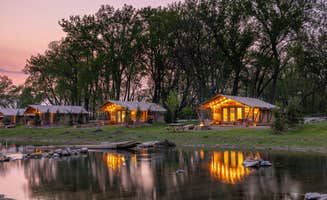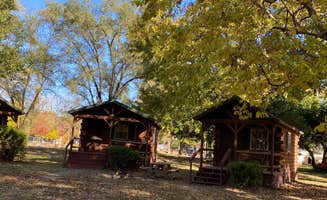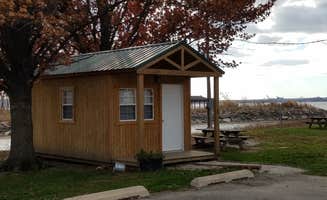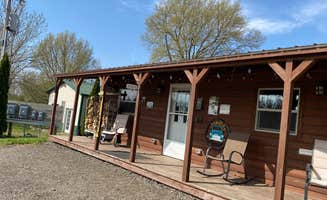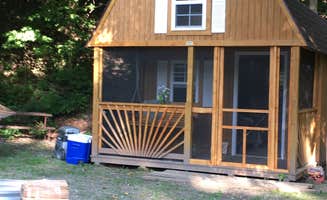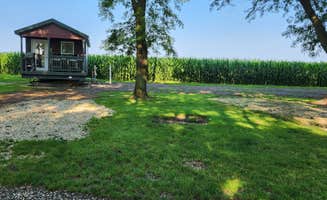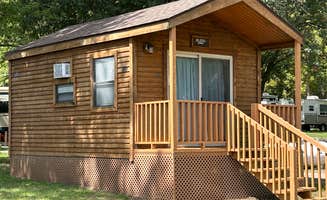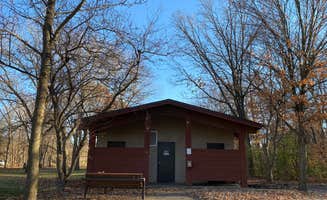Cabin camping near Chillicothe, Illinois provides access to both riverside and woodland settings along the Illinois River at elevations of approximately 450-500 feet. Most campgrounds in the region experience seasonal flooding in spring, with summer humidity levels often exceeding 80% during July and August. Winter cabin availability varies significantly, with fewer than half of area campgrounds maintaining year-round operations.
What to do
Fishing access: 3 minutes to Illinois River. Carl Spindler Campground sits directly on the Illinois River shoreline with dedicated angling spots. "There is a small beach area where you can access the water and a community fire pit which seemed to draw a lot of people in the evening," notes a visitor to Carl Spindler Campground.
Hiking woodland trails: 1-8 miles of connected paths. The nature preserve surrounding Millpoint Park offers hiking paths both north and south of the property. "There's decent hiking paths to explore both north and south of the property, with the latter offering up a small beachhead at Funks Run," explains a camper at Millpoint Park.
Kayaking calm waters: Rental equipment available. Chief Keokuk Campground provides seasonal watercraft rentals for lake exploration. "They rent kayaks, paddleboats, and basic fishing boats. There's some good fishing, if that's your thing," says a reviewer from Chief Keokuk Campground.
What campers like
Spacious sites: 30+ feet between most cabins. The camping areas at Millpoint Park offer generous spacing compared to other facilities. "Large sites on Illinois River. FHU. They do sell firewood, pickup your trash, and have two showers available," comments a Millpoint Park visitor.
River views: Western sunset visibility. Many cabins and campsites face the Illinois River or Upper Peoria Lake, offering scenic views. "You'll be sipping Mai Tais leaning back in your camp chair listening to some Amy Winehouse watching the sun set in the west over the Illinois River as the twinkling stars come out to shine," describes a camper at Carl Spindler Campground.
Shade trees: Pine forest setting. The established pine groves at Chief Keokuk create ideal conditions for outdoor relaxation. "It's nestled in a pine forest so if you love hammock camping, this place is perfect. The sites are spread out enough that you don't feel like you are on top of other campers," explains a Chief Keokuk camper.
What you should know
Water quality concerns: Iron content in water supply. Several campgrounds have high mineral content in their water systems. "Water has a lot of iron so does smell/taste weird," notes a reviewer at Millpoint Park.
Bathroom facilities: Limited capacity during peak times. Most cabin camping areas share communal bathrooms with varying conditions. "The campground only had two restrooms available during our stay. But they were nice," reports a Millpoint Park visitor.
Seasonal closures: Limited winter cabin options. Availability changes dramatically between seasons. "We came in for Thanksgiving. We had a great spot! The campground was clean and quiet," mentions a visitor to Carl Spindler Campground.
Tips for camping with families
Playgrounds: Limited equipment at most sites. Family-oriented facilities vary significantly between campgrounds. "A little further away is Old Mill Vineyard. Well worth the 20 minute drive! The wine and ambiance are very nice," suggests a Millpoint Park camper.
Booking timing: Reserve 3-6 months ahead for summer weekends. Many campgrounds fill completely during peak season. "Book early - reservations open online 6 months in advance and book up quickly. Most summer weekends are completely full," advises a visitor to Starved Rock Campground.
Insect protection: Heavy tick and gnat presence May-September. Pests require specific preparation for comfortable camping. "Bring good DEET spray to keep the ticks away as well as hard-core smoke or scent-fused candles that are peppermint, eucalyptus or lavender-scented to keep the gnats at bay," recommends a Millpoint Park camper.
Tips from RVers
Site spacing: Varies dramatically between campgrounds. Some RV areas provide minimal separation between sites. "You have very little room between you and your neighbor," reports a visitor to Lasalle/Peru KOA.
Hookup arrangements: Extended power cords needed at some sites. Electric outlets can be positioned inconveniently in some camping areas. "While I always pack a long 100 foot electrical cord for all of my electricity needs, I've never had to use it, except here, where the electrical outlet in the primitive tent camping area is shared by all 4 sites," explains a Carl Spindler camper.
Flooding risk: Low-lying sites vulnerable after heavy rain. Seasonal water level changes affect site conditions. "The bulk of the campsites are down in a valley and ours was along the creek. A heavy downpour resulted in water up over our ankles all through the site," warns a visitor to Pleasant Creek Campground.


